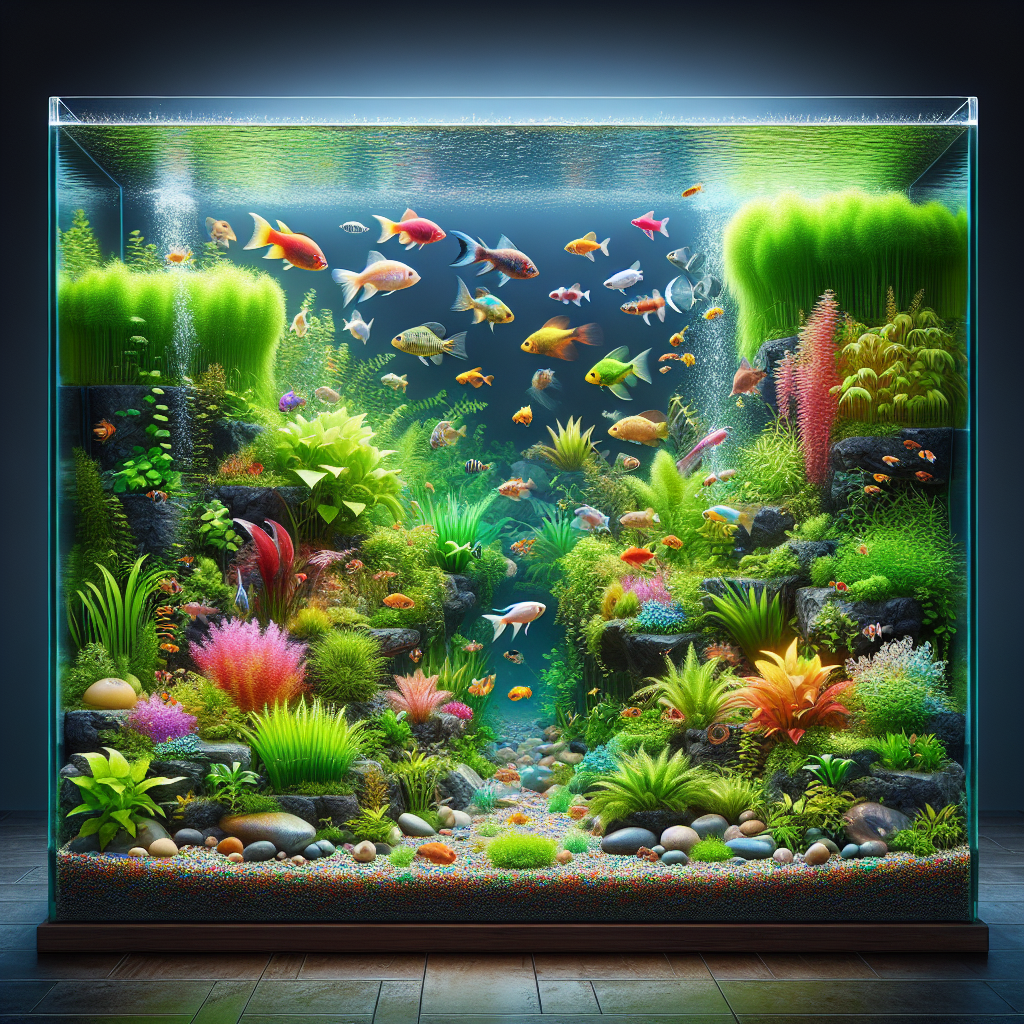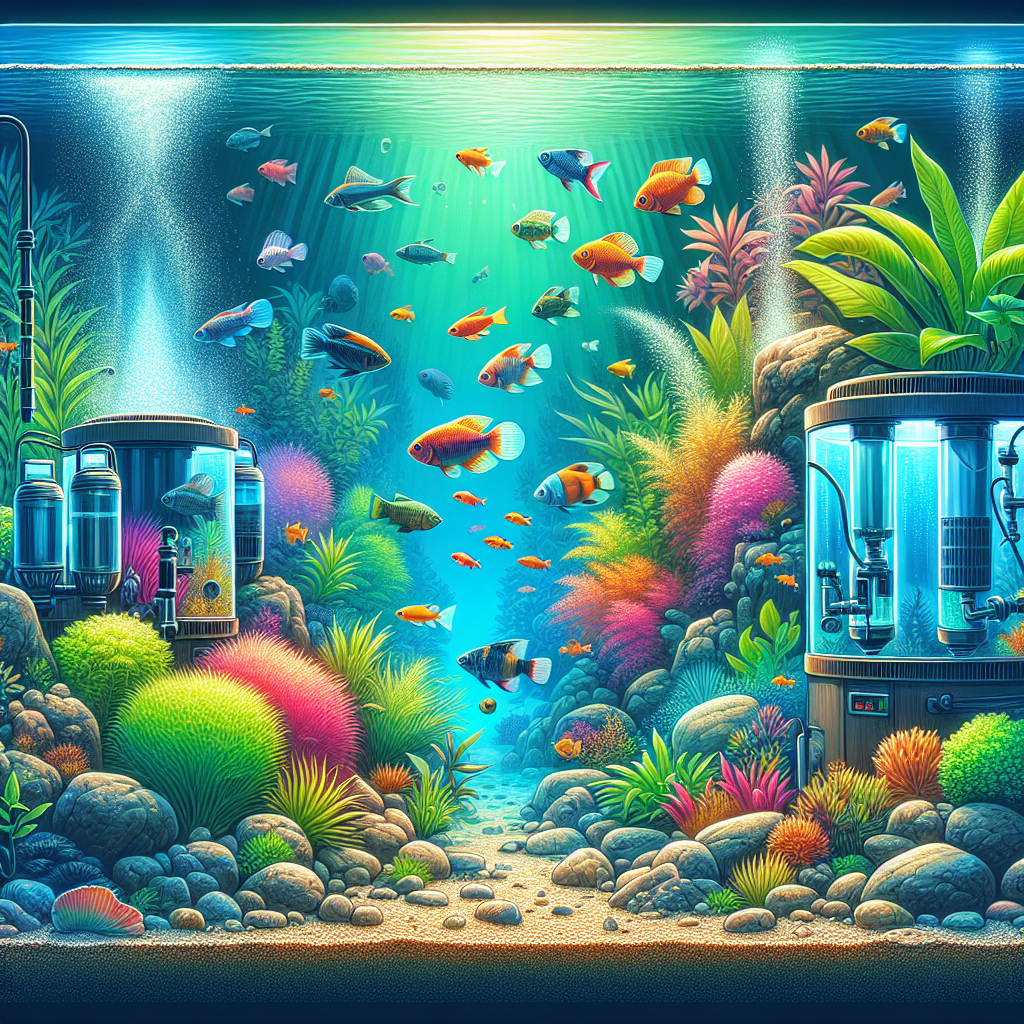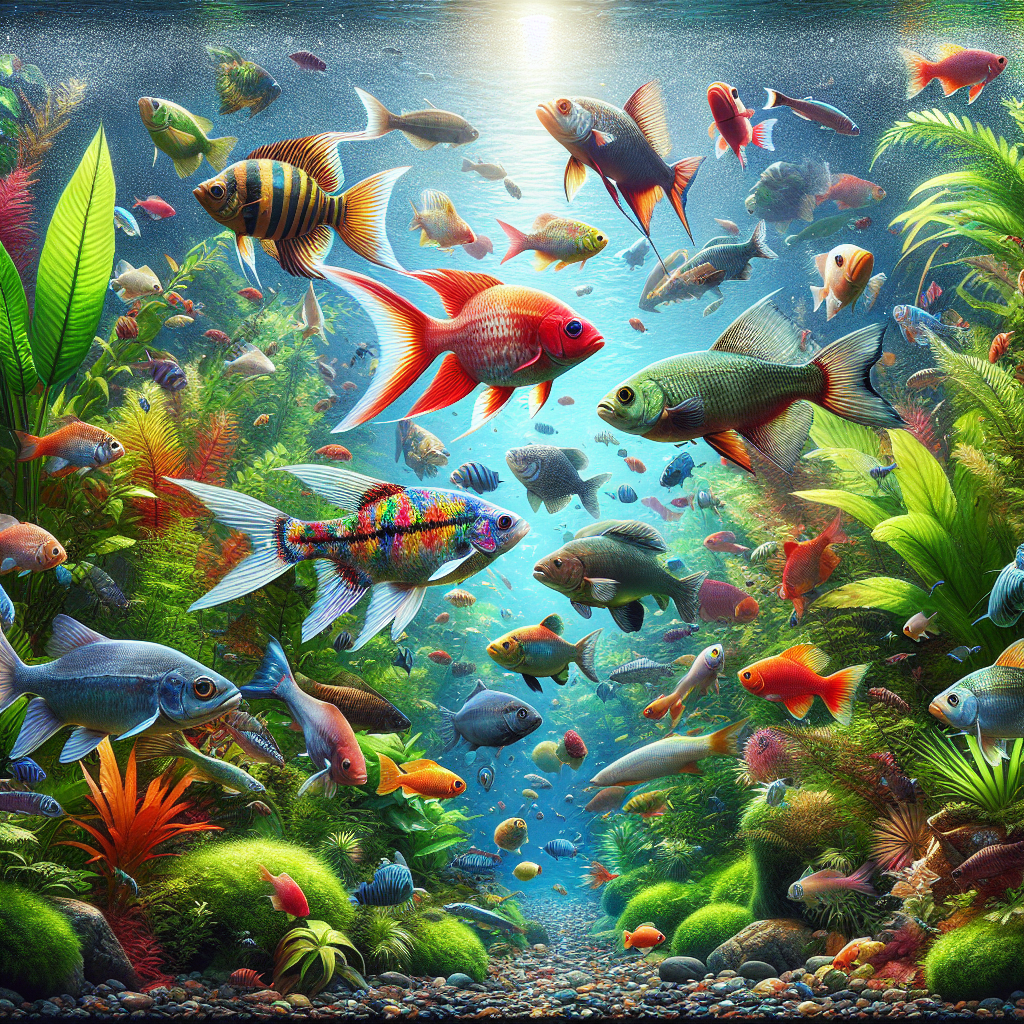A Comprehensive Guide to Freshwater Aquariums for Pet Fish
Exploring the captivating world of freshwater aquariums provides a unique opportunity to bring a slice of vibrant aquatic life into your home. Whether you’re a seasoned aquarist or a curious beginner, crafting a thriving underwater ecosystem is both a rewarding hobby and an art form. Freshwater aquariums not only serve as serene, living decor but also offer insights into the fascinating behaviors and interactions of aquatic life.
The allure of setting up a freshwater aquarium lies in transforming a simple tank into a bustling habitat filled with colorful fish, lush plants, and intricate landscapes. By carefully selecting and maintaining a variety of species, from the dazzling Betta splendens to the graceful Pterophyllum scalare, hobbyists can craft a dynamic environment that mirrors nature’s beauty. Understanding the delicate balance of water chemistry, the needs of individual species, and the design of the tank itself is crucial in achieving this vibrant aquatic haven.
This comprehensive guide is designed to equip enthusiasts with the knowledge and tools needed to successfully create and maintain a healthy freshwater aquarium. With the right approach, you can cultivate a flourishing aquatic ecosystem that captivates the eye and enriches the soul.
Selecting the Right Freshwater Aquarium for Your Fish

Choosing the perfect aquarium is essential not only for aesthetic appeal but also for ensuring a healthy environment for your aquatic pets. Why do some aquariums thrive while others struggle despite similar setups? The answer often lies in the initial choices made regarding the tank itself. This section explores critical considerations, including tank sizes and shapes, ideal locations, and necessary equipment.
Understanding Tank Sizes and Shapes
The size and shape of your tank are fundamental factors in setting up a successful freshwater aquarium. **Tank size** significantly influences the well-being of your fish, the stability of the aquatic environment, and even the time you’ll spend on maintenance. Although small tanks may seem manageable for beginners, they are often more challenging to maintain due to their sensitivity to changes in water chemistry and temperature.
When selecting a tank size, consider the species and number of fish you intend to keep. A general rule of thumb is to allocate one gallon of water per inch of fish, but this can vary depending on the species and their specific requirements. Neon tetras, for instance, thrive in schools and require more space to swim freely, whereas solitary fish like Betta splendens demand their own territory.
The **shape of the aquarium** also plays a crucial role. Rectangular tanks are popular due to their ample surface area, allowing for better oxygen exchange and providing more horizontal swimming space for fish. Cylindrical and bow-front tanks offer unique visual appeal but may pose challenges in terms of filtration and lighting uniformity.
Choosing the Ideal Location for Your Aquarium
The placement of your aquarium can greatly impact both the health of your fish and your enjoyment of the tank. An ideal spot should be stable, easily accessible for maintenance, and provide a backdrop that enhances the viewing experience.
Avoid placing the aquarium in **direct sunlight**, which can lead to rapid algae growth and fluctuations in water temperature, stressing the fish. Areas near windows, heaters, or air conditioning vents should also be avoided due to potential temperature variations. Instead, opt for a spot with a **consistent room temperature** and minimal exposure to natural light.
Consider the **viewing angle** and the room’s traffic flow. A well-placed aquarium can serve as a focal point in a living room or office, providing relaxation and visual interest. Ensure the location allows easy access for feeding, cleaning, and equipment maintenance. According to Aquarium Source, a sturdy stand or cabinet is necessary to support the weight of the filled tank, which can be substantial.
Essential Equipment and Accessories
Setting up a successful freshwater aquarium requires more than just a tank and water. Equipping your setup with the right tools and accessories is crucial for creating a stable and thriving environment for your fish.
**Filtration systems** are perhaps the most vital component, as they help maintain water quality by removing waste and toxins. There are three main types of filtration: mechanical, biological, and chemical. A **canister filter** or **hang-on-back filter** is often recommended for beginners due to their ease of use and effectiveness in managing a healthy balance of water parameters.
**Lighting** is another essential aspect, influencing both the well-being of fish and the growth of aquatic plants. LED lights are a popular choice due to their energy efficiency and adjustable intensity. When selecting lighting, consider the specific needs of your fish and plants, as some species require more light than others.
Additional equipment such as **heaters**, **thermometers**, and **air pumps** might be necessary depending on the species you choose to keep. Tropical fish, for example, often require heated water to thrive, while others may benefit from additional oxygenation provided by an air pump.
**Decorative elements** like substrate, rocks, and plants not only enhance the visual appeal of your aquarium but also provide essential hiding spots and territories for fish. When selecting decorations, ensure they are safe for freshwater aquariums and do not alter the water chemistry.
By carefully considering these factors and investing in quality equipment, you can create a vibrant and sustainable underwater world that brings joy and tranquility to your space. Remember, the choices you make at this stage can greatly influence the success of your aquarium journey.
Designing a Thriving Aquatic Environment

Crafting an aquatic paradise involves more than just selecting a tank and installing equipment. It’s about fostering a vibrant, self-sustaining ecosystem where fish and plants coexist harmoniously. Achieving this delicate balance starts with understanding the essential components that contribute to a thriving aquatic environment. This section explores the intricate relationship between substrate, plants, and the overall ecosystem, ensuring your freshwater aquarium flourishes.
Substrate and Plant Selection
The foundation of any successful aquarium is the substrate and plant life within it. The substrate serves as the bedrock of your underwater world, providing both a base for plants to root and a surface for beneficial bacteria to colonize. When choosing a substrate, consider the needs of your aquarium’s inhabitants and the aesthetic you wish to achieve.
Substrates come in various forms, including gravel, sand, and specialized planting media. **Gravel** is popular for its ease of cleaning and variety of colors, while **sand** offers a more natural look, ideal for tanks with bottom-dwelling species. For planted aquariums, a nutrient-rich substrate can promote healthier and more vigorous plant growth.
Plants play a crucial role in creating a balanced ecosystem. They not only enhance the visual appeal but also contribute to the health of the aquarium by absorbing carbon dioxide and releasing oxygen. When selecting plants, consider factors such as light requirements, growth rates, and compatibility with fish species. Anubias and Java fern are excellent choices for beginners due to their hardiness and minimal care needs.
Benefits of Live Plants
Why opt for live plants over artificial ones? The advantages extend beyond aesthetics. Live plants offer numerous ecological benefits that enhance the well-being of your fish and the overall health of the aquarium.
Live plants help stabilize water quality by absorbing nitrates and other toxins, reducing the frequency of water changes. They also provide natural hiding spots and breeding grounds for fish, reducing stress and promoting natural behaviors. Furthermore, the presence of live plants can prevent the growth of algae by competing for nutrients, ensuring your aquarium remains clean and vibrant.
Incorporating a variety of plant species can mimic natural ecosystems, offering diverse habitats and food sources for different fish species. As biologist Dr. Sylvia Earle once said, “With every drop of water you drink, every breath you take, you’re connected to the sea. No matter where on Earth you live.” This connection is mirrored in aquariums, where thriving plant life fosters a more natural and balanced environment.
Creating a Balanced Ecosystem
Achieving a balanced ecosystem in your aquarium is akin to orchestrating a symphony where each component plays a vital role. From filtration systems to the careful monitoring of water quality, every element must work in harmony to support aquatic life.
The Role of Filtration and Aeration
Filtration and aeration are the unsung heroes of a healthy aquarium. Proper filtration ensures that waste products and toxins are effectively removed, maintaining the delicate balance of water chemistry. Filters come in various types, each serving a specific purpose:
– **Mechanical filtration** removes visible debris and particles.
– **Biological filtration** encourages the growth of beneficial bacteria that break down harmful substances.
– **Chemical filtration** targets specific contaminants using activated carbon or resins.
Aeration, on the other hand, increases oxygen levels in the water, essential for the respiration of fish and beneficial bacteria. An air pump or powerhead can help achieve this by promoting water movement and gas exchange at the surface. Together, these systems create a stable environment where fish can thrive.
Maintaining Water Quality
Water quality is the lifeblood of any aquarium, and maintaining it requires diligence and understanding. Regular testing and adjustments are necessary to keep parameters such as pH, ammonia, nitrite, and nitrate levels within safe ranges. According to a study by Aquarium Source, consistent water quality is linked to healthier fish and fewer disease outbreaks.
Establishing a routine for water changes, typically 10-20% weekly, helps dilute accumulated toxins and replenish essential minerals. Additionally, monitoring temperature is crucial, as fluctuations can stress fish and lead to health issues. Most freshwater species thrive in temperatures between 72°F and 78°F, but specific requirements may vary.
Incorporating a digital water testing kit can provide accurate readings, allowing for timely interventions. By understanding and controlling water quality, you foster an environment where fish and plants can flourish, ensuring the success of your aquatic sanctuary.
In summary, crafting a thriving aquatic environment requires thoughtful planning and ongoing commitment. By selecting the right substrate and plants, ensuring effective filtration and aeration, and maintaining optimal water quality, you create a vibrant and sustainable underwater world. This meticulous care not only benefits your fish but also transforms your aquarium into a captivating living masterpiece.
Caring for Your Freshwater Aquarium and Its Inhabitants

Imagine coming home to find your fish gliding gracefully through crystal-clear water, their vibrant colors a testament to your dedication. Maintaining such a serene aquatic scene involves more than just admiration; it requires consistent attention to feeding, health monitoring, and cleaning routines. This section provides insights into maintaining the well-being of your underwater world.
Feeding and Nutrition for Pet Fish
Feeding your fish might seem straightforward, but it’s a balance of nutrition, species-specific needs, and moderation. Different fish species have distinct dietary requirements, which, if not met, can lead to health issues.
A balanced diet for your fish involves a mix of flakes, pellets, and frozen or live foods. Flakes and pellets are convenient and nutritionally balanced, but it’s crucial to choose products that cater to the specific dietary needs of your fish. For instance, herbivorous fish like Otocinclus benefit from algae wafers, while carnivorous species such as Bettas thrive on protein-rich foods like bloodworms.
Overfeeding is a common pitfall for beginners, leading to poor water quality and health problems for fish. A general guideline is to feed an amount that your fish can consume within 2-3 minutes. Observing your fish during feeding times can also provide insights into their health and behavior. According to a study published by Aquarium Source, varied diets contribute to vibrant colors and increased vitality in fish, enhancing their overall appearance.
Monitoring Fish Health and Behavior
Wondering how to tell if your fish are healthy? Observing their behavior and physical condition is key to detecting any issues early. Healthy fish are typically active, with bright colors and intact fins, while signs of illness include lethargy, faded colors, and abnormal swimming patterns.
Regularly monitoring your fish allows you to identify potential health problems before they become severe. Look for signs of stress or disease, such as white spots, cloudy eyes, or labored breathing. These symptoms could indicate issues like ich, bacterial infections, or poor water quality. As marine biologist Sylvia Earle emphasizes, “The best way to observe a fish is to become a fish.” This means immersing yourself in their world to understand their needs and behaviors.
In addition to visual checks, maintaining a log of water parameters and any changes in fish behavior can be invaluable. This information helps identify patterns that may indicate underlying issues. If you notice persistent problems, consulting with a veterinarian specializing in aquatic life or seeking advice from an experienced aquarist can provide solutions tailored to your aquarium’s needs.
Regular Maintenance and Cleaning Routines
Maintaining a pristine aquatic environment requires more than occasional cleaning; it involves establishing a consistent routine that keeps your aquarium in top condition. Regular maintenance ensures that your fish and plants thrive in a healthy ecosystem.
Start by scheduling weekly water changes of 10-20% to remove accumulated waste and toxins, replenishing essential minerals. During water changes, use a gravel vacuum to clean the substrate, removing uneaten food and debris. This prevents the build-up of harmful substances that can compromise water quality.
In addition to water changes, routine checks of equipment such as filters, heaters, and lights are crucial. Clean filter media as needed, but avoid over-cleaning, which can disrupt beneficial bacterial colonies essential for biological filtration. Adjust lighting and temperature settings to match the seasonal changes, ensuring optimal conditions for your aquarium’s inhabitants.
Lastly, regularly inspect and clean decorations, rocks, and plants to prevent algae overgrowth and maintain aesthetic appeal. By establishing a structured maintenance routine, you create a stable environment where your freshwater aquarium can flourish, bringing joy and tranquility to your space.
In conclusion, caring for your freshwater aquarium and its inhabitants is a rewarding journey that involves dedication, observation, and proactive maintenance. By mastering feeding practices, monitoring fish health, and implementing regular cleaning routines, you ensure a thriving aquatic environment that continues to captivate and inspire.
Embracing the Art of Freshwater Aquariums: A Celebration of Underwater Life
Creating a vibrant freshwater aquarium is a journey of discovery and artistry, offering an enriching experience for both novice and seasoned enthusiasts. By selecting the right tank and ideal location, you lay the foundation for a thriving aquatic habitat. The choice of essential equipment ensures the stability and health of your ecosystem, while thoughtful substrate and plant selection enhance its natural beauty and functionality.
The harmonious interplay of filtration, aeration, and water quality management is crucial in sustaining a balanced environment where fish and plants can flourish. By understanding the specific needs of your aquatic inhabitants, you can provide optimal care through tailored feeding practices and vigilant health monitoring. Regular maintenance routines further ensure the longevity and vitality of your aquarium, transforming it into a captivating living masterpiece.
Ultimately, a freshwater aquarium is more than just a decorative addition to your home; it is a window into the wonders of aquatic life. As you nurture this underwater world, you foster a deeper connection with nature, finding joy and tranquility in the colorful dance of your aquatic companions.